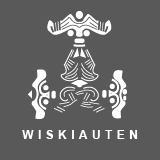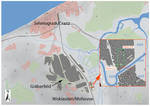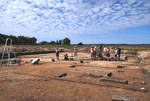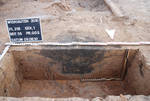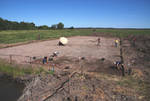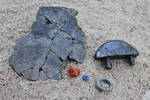Results summer 2010
The excavations in 2010 took place from the 16th of June until the 19th of August. They were conducted with the help of students of the institute of Proto- and Prehistory of the Christian-Albrechts-University Kiel and the Immanuel-Kant-University Kaliningrad.
The works concentrated on the area approx. 800 m east of the barrow cemetery. Here former investigations had brought to light several settlement traces of the second half of the 1st Millennium, which were checked by a regular excavations in 2009 in excavation area 21A (see results 2009). This excavation uncovered two fire places and some 20 postholes of at least one bigger building. By finds and C14-dates it is possible to date these settlement activities into to the 9th and 10th cent. AD.
The new excavation trenches 21B and 21C with an overall size of 600 sqm were opened up to the West and North of the last years excavation area 21A (fig. 1). Excavation trench 21B had a size of 50x30 m, but only two thirds were excavated (fig. 2), whereas the smaller excavation 21C with 4.5x10.5m was completely unearthed.
The smaller excavation 21C contained the same thick occupation layers as area 21A with a lot of finds but without any clearly structured objects. Excavation trench 21B was much richer in features. All together 3 fireplaces and 30 certain and a smaller number of uncertain postholes were discovered (fig. 3). All these features were concentrating on the eastern part of area 21B. They probably belong to several houses, of which one was uncovered completely. A second house was unearthed partly, and a third ground plan can be assumed only. In addition already before the excavations a geophysical survey was conducted (fig. 4). After removing the first 30 cm of Humus the whole area of investigation was scanned in a very high 10cm-grid with Georadar and Geomagnetics. The resulting pictures show a larger number of anomalies which – due to the excavation results – can preliminary be interpreted as postholes.
Next to the ground plans 5 waste pits were examined, containing not more then a few pottery fragment and some badly preserved animal bones. In all the profiles a thin cultural layer, badly disturbed by agricultural work and bioturbation, was following the slightly rising topography from South to North. This cultural layer was nearly empty except the areas with a high concentration of postholes and other features. Here it contained a considerable number of small finds.
On the one hand a lot of animal remains were retrieved and have been analysed in a diploma thesis by S. Knorre (CAU Kiel) in cooperation with the Archaeozoological working group of the Archaeological States Museum Schleswig. On the other hand a lot of pottery fragments were found. With 3 exceptions they belong to handmade pottery, whereas wheel made pottery, coming up in the region not earlier than the year 1000, is missing completely. This might show the settlement’s abandonment shortly after the turn to the 11th cent. AD – exactly the time, when the barrow cemetery is running out of use as well.
Remarkable is the rising number of amber finds. It was mostly found as raw material, but also with traces of handicraft or in form of finished beads. The Kaliningrad region, especially the Sambian peninsula, has the world’s highest natural concentration of amber, and this did not only attract the Scandinavians. It is believed that amber has been the source of trade and economical prosperity in all archaeological periods.
A glass bead, two bronze fingerings, fragments of combs and a lot of iron nails and rivets are completing the list of finds (fig. 5). The most interesting find was a sword hilt with fine silver inlays which finds exact parallels in the 10th cent. barrows in the Scandinavian cemetery of Wiskiauten. It connects the settlement traces of excavation areas 21A-C with the barrow cemetery and shows general contacts to the Scandinavians, but still it is an unsolved question, weather the Scandinavians lived here themselves or if the houses were inhabited by local Prussian people.
The excavated part of the settlement proves an extension of 30 x 60 m, but due to several drillings and test pits the whole settlement can be estimated to a size of 6 hectares.
In the upcoming, for now last field campaign in 2011 new excavations will be carried out to clarify the character of the settlement. But furthermore also other places in this huge and extremely densely settled area will be checked by archaeological investigation because there are several more hints for contemporary settlement activities.
[top]
